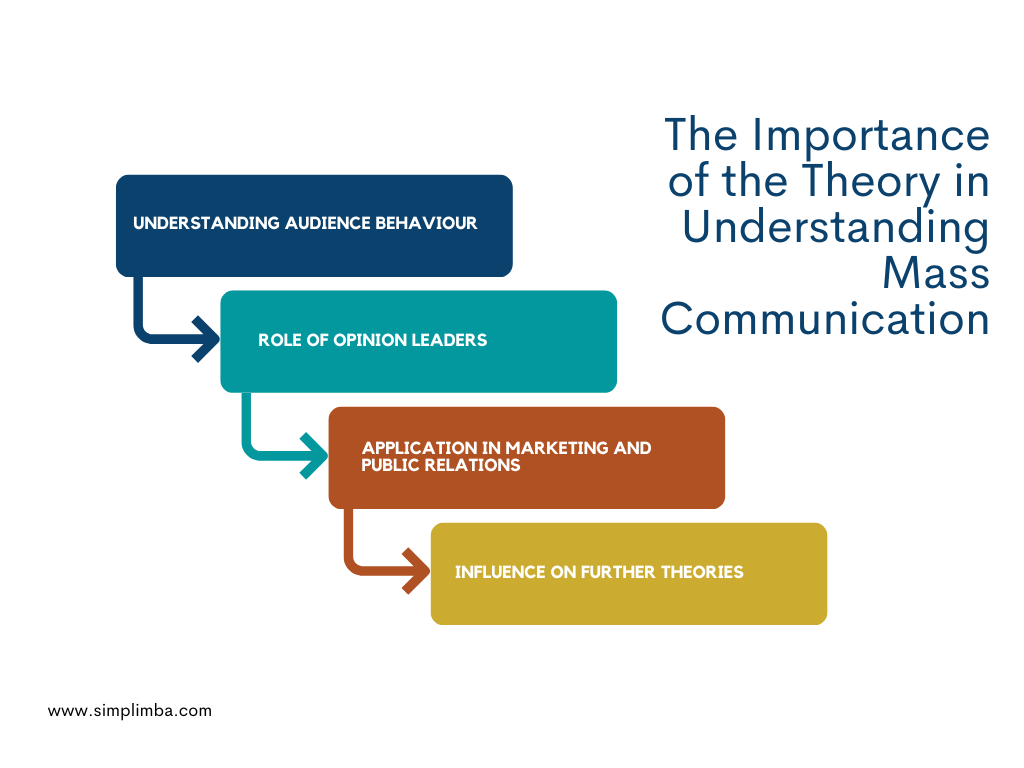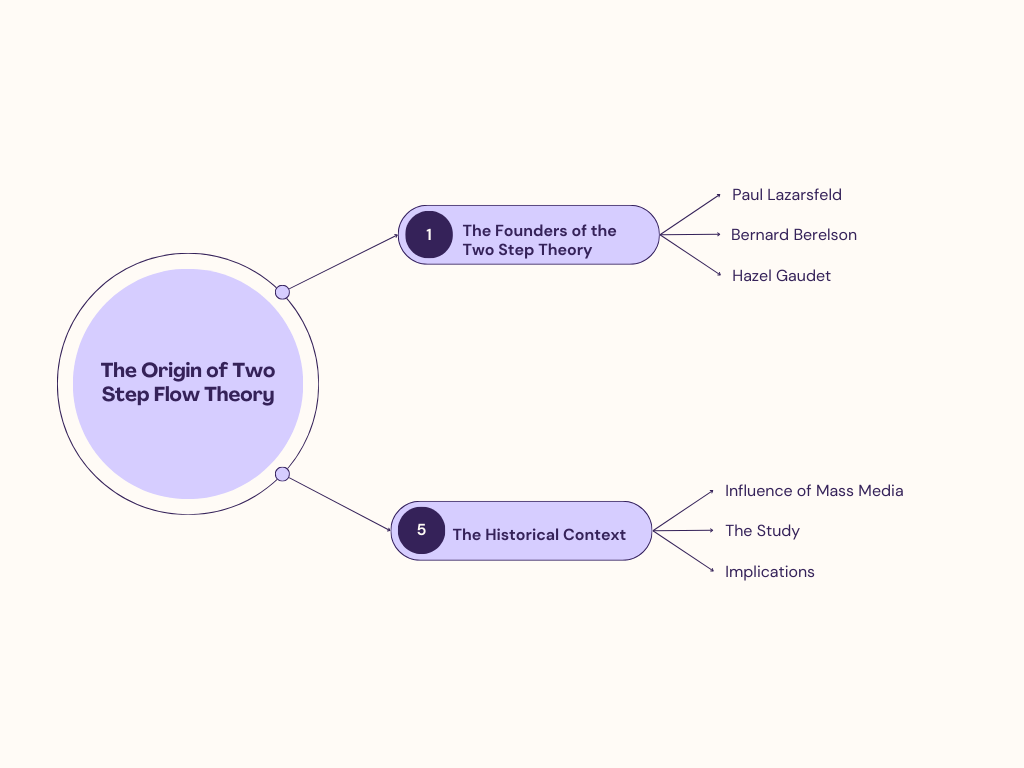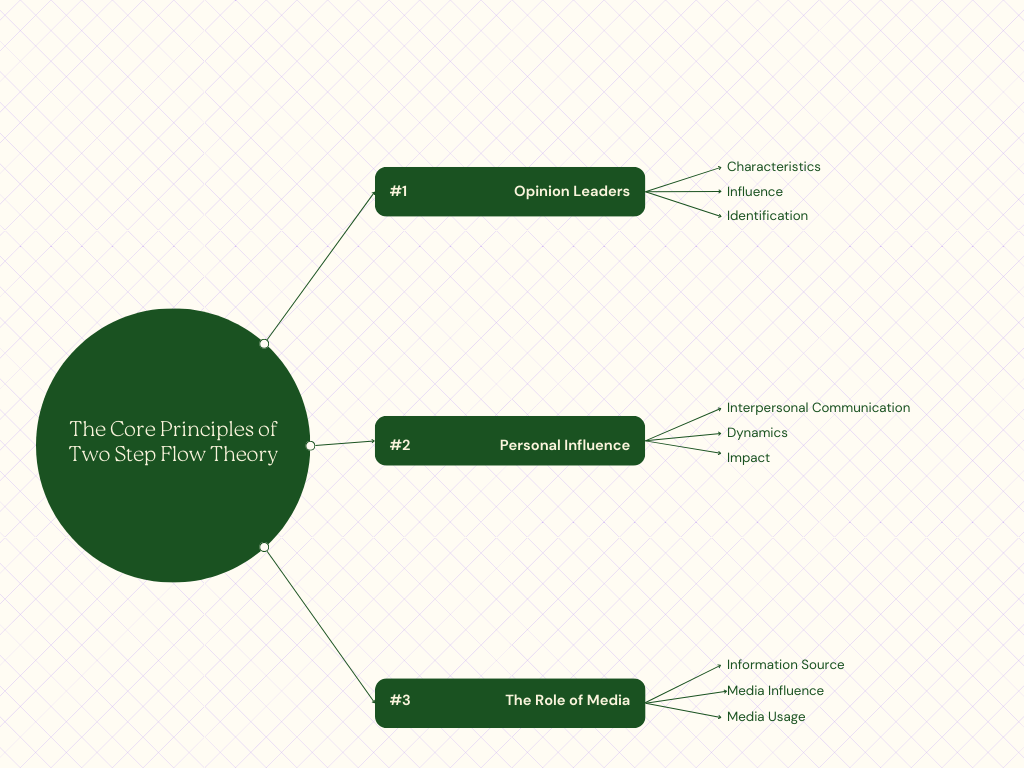Definition of Two Step Flow Theory
The Two Step Flow Theory is a significant concept in the field of mass communication, first proposed by sociologist Paul Lazarsfeld in the mid-20th century. This theory contests the traditional model of mass communication, which suggests that media messages are directly received and processed by the audience. Instead, Lazarsfeld posited that the flow of media messages takes a ‘two-step’ path, whereby information is first interpreted by ‘opinion leaders’ who then influence the attitudes and behaviors of those in their social networks.
In more technical terms, the two-step flow theory can be described as follows:
Let ‘I’ denote the information from media sources, ‘O’ the opinion leaders, and ‘A’ the audience. The traditional ‘one-step’ model assumes I→A. In contrast, the two-step flow theory posits I→O→A, indicating the mediating role of opinion leaders in the flow of information.
The Importance of the Theory in Understanding Mass Communication
The Two Step Flow Theory has profoundly affected how we understand mass communication and its impact on society. It deviates from the conventional ‘hypodermic needle’ or ‘bullet’ model, which saw audiences as passive receivers of media messages, susceptible to direct influence.

Understanding Audience Behaviour: The theory helps explain why certain media campaigns may fail despite presenting logical and persuasive messages. If opinion leaders are not engaged or convinced, the message is less likely to resonate with the broader audience.
Role of Opinion Leaders: The theory underscores the pivotal role of opinion leaders in shaping public opinion. These individuals often have expert knowledge or are highly respected in their communities, allowing them to influence others’ attitudes and behaviours.
Application in Marketing and Public Relations: The theory has practical implications, particularly in fields like marketing and PR. Businesses and organizations can target opinion leaders to help disseminate their messages more effectively.
Influence on Further Theories: The two step flow theory laid the foundation for subsequent theories in communication studies, such as the diffusion of innovations theory, which also focuses on the role of key individuals in spreading information within their social networks.
The Origin of Two Step Flow Theory

The Founders of the Two Step Theory
The Two Step Flow Theory was primarily proposed by Paul Lazarsfeld, Bernard Berelson, and Hazel Gaudet in their 1944 study of the voting patterns in the United States during the 1940 presidential election.
Paul Lazarsfeld: Lazarsfeld was an American sociologist and communications researcher who is widely regarded as one of the most influential figures in the field of communication studies. He was instrumental in the development of the Two Step Flow Theory, which fundamentally changed the way we understand mass communication and its influence on society.
Bernard Berelson: Like Lazarsfeld, Berelson was also a key figure in communication research. He was an American behavioral scientist who specialized in the study of communications, public opinion, and voting behavior. Along with Lazarsfeld and Gaudet, he conducted extensive research into the role of mass media in shaping public opinion.
Hazel Gaudet: Gaudet was a research associate who worked closely with Lazarsfeld and Berelson. While less known than her colleagues, her input and contributions to the research were fundamental to the conceptualization and development of the Two Step Flow Theory.
The Historical Context
The Two Step Flow Theory was developed in the mid-20th century, during a period of significant change and development in mass media. The theory emerged from a study of the 1940 presidential election, which was one of the first elections in which mass media (particularly radio and newspapers) played a critical role.
Influence of Mass Media: Prior to the study, the prevailing belief was that mass media had a direct and powerful influence on individuals’ attitudes and behaviors. This was known as the “hypodermic needle” or “magic bullet” model of communication. However, the results of the study suggested a more complex relationship between media and its audiences.
The Study: The study found that information from mass media first reached “opinion leaders”, individuals who consumed more media and were more politically active than average people. These opinion leaders then interpreted and disseminated the information to their personal networks, influencing the attitudes and opinions of those within their circles. This process, whereby information flows from mass media to opinion leaders and then to wider audience, became known as the “two step flow” of communication.
Implications: The Two Step Flow Theory had a profound impact on subsequent research in communications and media studies. It shifted the focus from the direct effects of media on individuals to the interpersonal relationships that mediate the flow of information. This led to further developments in the understanding of how media influences society, including the concepts of framing, agenda-setting, and the spiral of silence.
The Core Principles of Two Step Flow Theory

Opinion Leaders
Opinion leaders play a critical role in the two step flow theory. They are considered influential within social networks due to their ability to absorb, interpret, and disseminate information from mass media to their followers or group members.
Characteristics: Opinion leaders are generally more exposed to the media and are more socially active. They possess high social status and embody certain competencies that make them credible and influential. These may include expertise in a certain field, high education levels, or a vast experience array.
Influence: They act as a bridge between the media and the general public, interpreting and translating the media’s messages. Opinion leaders, through personal influence, can shape individuals’ thoughts, beliefs, and behaviors.
Identification: Identifying opinion leaders can be challenging. However, researchers often use techniques such as self-reporting (individuals self-identifying as opinion leaders), key informants (individuals known to be knowledgeable about a specific network), or sociometric methods (network analysis through surveys).
Personal Influence
Personal influence refers to the process by which opinion leaders impact the attitudes, beliefs, and behaviors of others in their social network.
Interpersonal Communication: Personal influence primarily operates through interpersonal communication, which is often more persuasive than mass media due to its face-to-face nature and the trust between the communicating parties.
Dynamics: The dynamics of personal influence include conformity (aligning beliefs with the group), normative influence (modifying behavior to fit into the group), and informational influence (relying on others for information).
Impact: The impact of personal influence can be measured by changes in attitudes, beliefs, or behaviors among group members. These changes can be gauged using pre-test/post-test designs, surveys, or observational methods.
The Role of Media
In the two step flow theory, mass media are the source of information that opinion leaders gather, interpret, and disseminate.
Information Source: Mass media, including newspapers, radio, television, and digital platforms, provide a wealth of information that opinion leaders can leverage.
Media Influence: While direct media influence on the public is limited in this theory, its effects on opinion leaders are pivotal. The media’s role in shaping public opinion is therefore indirect but vital.
Media Usage: Understanding media usage by opinion leaders can provide insight into their influence. This can be achieved through content analysis, surveys, or media usage diaries.
The Application of Two Step Flow Theory in Modern Management and Leadership
Crisis Management
Theoretical Framework: Two Step Flow Theory (TSFT) suggests that ideas flow from mass media to opinion leaders and from them to a wider audience. Modern crisis management involves rapid decision making under high uncertainty and significant constraints. In this context, TSFT can be applied by recognizing key opinion leaders within or outside the organization who can facilitate the flow of critical information during crisis situations.
Case Studies: Numerous crisis situations, including the global financial crisis of 2008 and the COVID-19 pandemic, have highlighted the efficacy of utilizing TSFT in management. In both instances, the role of opinion leaders, such as policymakers, economists, and health experts, was instrumental in disseminating pertinent information and influencing public behavior.
Practical Implications: Implementing this theory in crisis management could mean identifying these key opinion leaders early in the crisis, fostering relationships with them, and leveraging their influence to ensure the effective dissemination of crisis communication.
Public Relations and Corporate Communications
Theoretical Framework: TSFT can help shape public relations strategies by identifying key influencers or opinion leaders who can effectively convey the company’s messages to their followers. These opinion leaders can be within the organization (e.g., top managers or supervisors) or external (e.g., media personalities, sector experts, or widely followed customers).
Case Studies: Evidence can be found in successful PR campaigns like Dove’s Real Beauty Sketches, which relied on key opinion leaders in the beauty and fashion industry to spread their message of self-acceptance and body positivity.
Practical Implications: Companies can use this approach to develop a more targeted and effective PR strategy. By focusing their efforts on influencing opinion leaders, they can ensure that their messages reach a wider audience and have a greater impact.
Leadership Influence and Employee Engagement
Theoretical Framework: TSFT applies to leadership and employee engagement because it recognizes the influence of key opinion leaders within an organization. These opinion leaders are not always those in formal leadership positions. They can be anyone who has the respect and attention of their peers.
Case Studies: Google’s Project Oxygen and Project Aristotle provide great examples of how recognizing and leveraging opinion leaders can impact employee engagement and team performance.
Practical Implications: By recognizing these opinion leaders, leadership can foster a more engaged and motivated workforce. Leaders can also use these opinion leaders to disseminate critical information, drive change, and foster a more inclusive and positive organizational culture.
Criticisms and Limitations of the Two Step Flow Theory
Oversimplification of the Communication Process
The Two Step Flow Theory, as coined by Paul Lazarsfeld, Bernard Berelson, and Hazel Gaudet, basically posits that information from the media moves in two separate stages. First, individuals (opinion leaders) who pay close attention to the mass media and its messages receive the information. Second, they pass on their own interpretations in addition to the actual media content. The theory thus essentially creates a “two step” flow of information from the media to the public. However, a significant criticism is its perceived oversimplification of the communication process.
Lack of consideration for multiple intermediaries: The theory assumes a linear process in which opinion leaders act as the sole intermediaries between the media and their followers. In reality, the flow of information is often much more complex and can involve multiple intermediaries, each adding their interpretations and biases to the information they pass on.
Ignoring the feedback loop: The two step flow theory does not account for the feedback loop that is an integral part of the communication process. Feedback from the audience can influence opinion leaders, who can, in turn, influence the media. This feedback loop is a significant part of modern communication processes but is largely ignored in the two step flow theory.
Neglecting the Power of Individual Agency
Another criticism is the theory’s neglect of the power of individual agency. The theory’s emphasis on the role of opinion leaders in shaping public opinion may underestimate the critical thinking abilities and discernment skills of the general public.
Underestimation of individual discernment: Modern audiences are not passive recipients of information. They are capable of critically analyzing the media content and forming their opinions, sometimes independent of opinion leaders.
Ignoring individual’s pre-existing beliefs and opinions: The two step flow theory also overlooks the fact that individuals have pre-existing beliefs and opinions that play a crucial role in interpreting and assimilating the information they receive.
Underestimating the Role of Mass Media
The two step flow theory has also been criticized for underestimating the role of mass media in shaping public opinion.
Direct Influence of Media: While the theory emphasizes the role of interpersonal relations in shaping public opinion, it somewhat downplays the direct influence of mass media. For instance, the advent of social media has increased the ability of mass media to directly influence public opinion with little to no mediation by opinion leaders.
Overemphasis on Opinion Leaders: The theory overly stresses the influence of opinion leaders, leaving the impression that mass media are not influential in their right. This view neglects the power of mass media to set the agenda and frame issues, thereby shaping public discourse.
These criticisms do not completely invalidate the two step flow theory. Instead, they highlight the need for a more comprehensive theory of communication that considers the complexity and dynamism inherent in the communication process. The two step flow theory was conceived in a different era, and while it still holds some relevance, it needs to be adapted or complemented by other theories to better reflect the realities of modern communication.
The Emergence of Multi-Step Flow Theory
The Two Step Flow Theory’s oversimplification of information flow is one of its primary criticisms. Researchers argue that the process involves more than two steps and is highly interconnected. This critique led to the emergence of the Multi-Step Flow Theory.
In the Multi-Step Flow Theory, the flow of information is not a linear process from media to opinion leader to opinion follower. Instead, it recognizes that individuals might get information directly from the media or through complex, networked interactions with others. It also emphasizes that individuals are not just passive recipients of information but actively seek and interpret it based on their needs and perspectives.
The Multi-Step Flow Theory better reflects the complexity of communication processes, where individuals can be opinion leaders in some contexts and opinion followers in others. It also recognizes that the influence of opinion leaders varies depending on the nature of the issue and the surrounding social networks.
The Influence of Social Media and Digital Communication Platforms on Two Step Theory
The rise of social media and digital communication platforms has further transformed and complicated the information flow. These platforms have enabled the emergence of multiple new opinion leaders, expanded the reach of existing ones, and increased the speed and complexity of information dissemination.
Modern digital platforms allow for an almost instantaneous flow of information, bypassing traditional gatekeepers in the media. It has also led to a new layer of complexity where individuals can be both consumers and creators of content. For example, through mechanisms like likes, shares, retweets, and comments, users don’t just passively receive information but also actively participate in shaping and spreading it.
The digital age has also introduced the concept of echo chambers and filter bubbles, where algorithms tailor information to users based on their previous interactions. These features can reinforce existing views and lead to polarization, which adds another layer of complexity to the multi-step flow theory.
Samrat is a Delhi-based MBA from the Indian Institute of Management. He is a Strategy, AI, and Marketing Enthusiast and passionately writes about core and emerging topics in Management studies. Reach out to his LinkedIn for a discussion or follow his Quora Page

